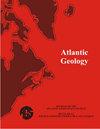New Cryogenian, Neoproterozoic, and middle Paleozoic U–Pb zircon ages from the Caledonia terrane, southern New Brunswick, Canada: better constrained but more complex volcanic stratigraphy
IF 0.9
4区 地球科学
Q2 GEOLOGY
引用次数: 3
Abstract
New U–Pb zircon ages from volcanic, plutonic, and sedimentary units in the Avalonian Caledonia terrane of southern New Brunswick provide better timing constraints in this geologically complex area. Previous ca. 620 Ma ages from the Broad River Group are now corroborated by additional dates from felsic tuff in the Gordon Falls Formation and rhyolite in the former Fairfield (now East Branch Black River) Formation of 620 ± 5 Ma and 622 ± 1.9 Ma, respectively. Combined with ages ranging from ca. 625 Ma to 615 Ma from crosscutting plutons, the data suggest that the minimum age of the Broad River Group is about 615 Ma. A quartzfeldspar porphyry dyke in mafic volcanic rocks of the previously undated Long Beach Formation yielded an igneous crystallization age of 685 ± 10 Ma, the oldest unit yet dated in the Caledonia terrane but similar in age to porphyry in the Stirling belt in the Avalonian Mira terrane of Nova Scotia. The age of the Coldbrook Group was constrained previously by U–Pb (zircon) ages of volcanic rocks between 560 and 550 Ma as well as by similar ages from comagmatic plutons. Five additional samples from both volcanic and plutonic units lie in the same range of 560–550 Ma, including errors, demonstrating that the Coldbrook Group and related plutons formed in less than 10 million years. Such a large volume of mainly felsic magma erupted and emplaced in a short time span suggests a “supereruption/supervolcano” environment such as the late Cenozoic southwestern USA but not yet recognized at ca. 560–550 Ma elsewhere in Avalonia. Two units yielded Paleozoic ages: felsite of the Bloomsbury Mountain Formation with a zircon population at 427 ± 9 Ma, indicating a Silurian maximum emplacement age, and dacite of the Grassy Lake Formation with several zircon grains at 382.8 ± 8.3 Ma, indicating a maximum age of middle Devonian, the first rocks of this age to be identified in the Caledonia terrane.加拿大新不伦瑞克省南部喀里多尼亚地体新寒冰系、新元古代和中古生代U-Pb锆石年龄:更好地约束但更复杂的火山地层
来自新不伦瑞克省南部阿瓦洛尼亚喀里多尼亚地体的火山、深成岩和沉积单元的新U-Pb锆石年龄为该地质复杂地区提供了更好的时间约束。先前来自Broad River Group的约620 Ma的年龄现在被Gordon Falls组的长英质凝灰岩和前Fairfield组(现为Black River East Branch)的流纹岩的620±5 Ma和622±1.9 Ma的年龄所证实。结合横切岩体约625 ~ 615 Ma的年龄,认为Broad River群的最小年龄约为615 Ma。长滩组基性火山岩中的石英长石斑岩岩脉的火成岩结晶年龄为685±10 Ma,是喀里多尼亚地体中最古老的单位,但其年龄与新斯科舍省阿瓦洛尼亚米拉地体中斯特林带的斑岩相似。Coldbrook群的年龄先前受到560 ~ 550 Ma火山岩的U-Pb(锆石)年龄以及岩浆岩体的类似年龄的限制。另外5个来自火山和深部岩体单元的样品位于560-550 Ma的相同范围内,包括误差,表明Coldbrook群和相关的深部岩体形成时间不到1000万年。如此大量的长英质岩浆在短时间内喷发和就位,表明美国西南部是晚新生代的“超级喷发/超级火山”环境,但在阿瓦洛尼亚其他地区约560-550 Ma尚未发现。两个单元测定了古生代的年龄:布卢姆斯伯里山组英安岩的锆石数量为427±9 Ma,表明其最大侵位年龄为志留纪;草湖组英安岩的锆石数量为382.8±8.3 Ma,表明其最大侵位年龄为中泥盆世,这是加里东尼亚地体中首次鉴定出该时代的岩石。
本文章由计算机程序翻译,如有差异,请以英文原文为准。
求助全文
约1分钟内获得全文
求助全文
来源期刊

Atlantic Geology
GEOLOGY-
CiteScore
2.10
自引率
18.80%
发文量
0
审稿时长
>12 weeks
期刊介绍:
Atlantic Geology (originally Maritime Sediments, subsequently Maritime Sediments and Atlantic Geology) covers all aspects of the geology of the North Atlantic region. It publishes papers, notes, and discussions on original research and review papers, where appropriate to the regional geology.
 求助内容:
求助内容: 应助结果提醒方式:
应助结果提醒方式:


